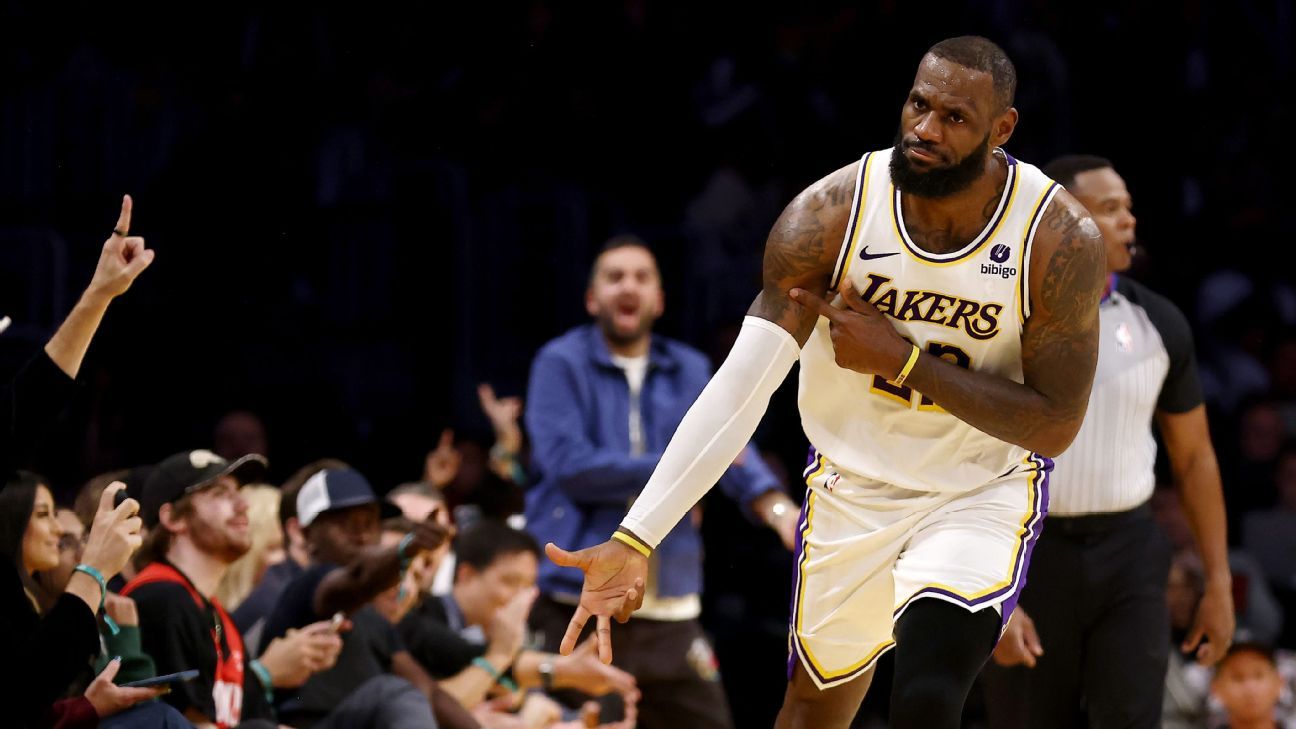Sports
How it started, how it's going: Checking in on early-season NBA promises – ESPN

Michael Wilbon reacts to Bradley Beal being out at least three weeks with a back injury. (1:26)
Tuesday marks exactly four weeks since the 2023-24 NBA regular season began. Most teams have played somewhere between 12 and 14 games — not quite a large enough sample to make definitive declarations about how they’ll finish this season, but more than enough to check in on how some preseason promises are paying off.
It’s easy for players, coaches and front offices to make lofty declarations in September, before anyone has taken the court. Teams promise to play a more uptempo style or limit stars’ minutes. They insist their newly assembled star pairings will fit seamlessly. But sometimes reality comes crashing in once the games start being played.
With that in mind, we asked our NBA experts to take a look at five teams that started with specific hopes to see how it’s going after a month.
The Phoenix Suns’ star trio of Devin Booker, Kevin Durant and Bradley Beal has yet to play a second together in the regular season. That won’t change until some time in December at the earliest, as Beal continues to deal with a lower back strain.
That’s a frightening development for a franchise that took a major risk in trading for Beal, even at a discounted price relative to his talent and career production. Beal came with durability concerns (74 games missed over the previous two seasons) that have only become more worrisome and a supermax contract ($207 million guaranteed over four seasons, with a no-trade clause) that serves as handcuffs on Phoenix’s front office. The Beal deal was likely the last big swing the Suns will get in their efforts to build a roster capable of winning a title around superstars Booker and Durant, thanks in part to the roster-building restrictions on teams over the second luxury tax apron built into the new collective bargaining agreement.
The good news is that Booker has flourished in his transition to a full-time point guard, small as the sample might be. A series of injuries (toe, ankle, calf) caused Booker to miss eight games, but the Suns’ offense has cooked with him on the floor. Phoenix has scored 125.8 points per 100 possessions in Booker’s minutes. He’s averaging 28.8 points and 9.8 assists per game, enhancing the brilliance of Durant while easing the burden on the 35-year-old future Hall of Famer.
“It’s good to have our point guard back,” Durant said after the Suns hung 133 points on the Minnesota Timberwolves’ top-ranked defense in Booker’s return from the calf strain.
It will be better once Beal joins them, providing the Suns with a star-caliber third option and allowing them to manage the workloads of their two superstars who have extensive injury histories of their own. Unfortunately, it’s uncertain when that will happen. — Tim MacMahon
The Chicago Bulls brought back nearly their entire roster from last season but vowed to change their style of play. The Bulls planned to play faster with a new offense that would get out in transition, generate more 3-pointers and unlock the group the way Lonzo Ball did for the first 35 games of his Bulls tenure.
Despite building a team around DeMar DeRozan, Zach LaVine and Nikola Vucevic, three veteran players who have made multiple All-Star games because of their offense, the Bulls have consistently been near the bottom of the league in that category since Ball suffered a knee injury that has kept him out since Jan. 14, 2022, and will cause him to miss this entire season as well.
Despite the vow to play faster, once again the Bulls find themselves 28th in the league in pace and 26th in offensive efficiency, per NBA.com. Last week, coach Billy Donovan acknowledged that with the Bulls’ current personnel, featuring three players who like to dribble and shoot a lot of midrange jump shots, it was not realistic for them to play at a pace with the rest of the league.
“Our team is not going to be this racehorse team,” Donovan said last week before a game against the Orlando Magic. “It’s just not. And that’s fine, you can still be effective and productive. You have to play to your personnel and what you have.
“We can do a better job on misses, but on made baskets, I think it’s important that we come down with a thrust, we’re organized with the floor spaced correctly and then we play from there.” — Jamal Collier
In the 2022-23 season, after an early January win against the cellar-dwelling Charlotte Hornets, Los Angeles Lakers coach Darvin Ham explained why he felt comfortable playing LeBron James for 39-plus minutes for the second game in a row.
“He’s just got it going,” Ham said of the 38-year-old James. “I just want to ride him. And he allows you to do that because he takes such great care of himself.”
As it turns out, Ham rode James until the wheels came off. The next month, James tore a tendon in his right foot in a win against Dallas in which he played 37 minutes. The injury cost James a month of games and hampered him during L.A.’s push to the conference finals.
Lesson learned.
Get exclusive access to thousands of premium articles a year from top writers.
• 5 potential free agent deals for Ohtani »
• Ranking the Premier League’s worst »
• Revealing our NFL All-Youngster Team »
More ESPN+ content »
Ham, in collaboration with Lakers vice president of basketball operations and general manager Rob Pelinka and James’ longtime athletic trainer, Mike Mancias, entered this season with a minutes guideline for the 21-year veteran. The goal was to play James 28 to 30 minutes per night, sources told ESPN, with the flexibility to extend if a tight fourth quarter or overtime required it.
The plan lasted all of one game, however. Ham played James 29 minutes in an opening-night loss to the Denver Nuggets, then James’ minutes climbed to 35 minutes in Game No. 2 and all the way to 39 in Game No. 3, an overtime loss to the Sacramento Kings.
With the Lakers’ depth tested by early-season injuries, the minutes cap has turned out to be, well, cap. The only time Ham has met the guideline has been in two blowouts when James didn’t play at all in the fourth quarter because the outcome was already decided. Otherwise the Lakers have repeatedly found themselves in close games down the stretch, and James’ minutes have blown past any limit.
Still, all parties involved aspire to limit James’ minutes when the team can get fully healthy, sources told ESPN. James has already missed one game in the early going because of a left calf injury, and the long-term goal is to get him to the finish line with the wheels still intact. — Dave McMenamin
When the Golden State Warriors traded for Chris Paul in July, they were bringing in a guard to anchor their second unit — be the floor general, control the game and provide a veteran presence for a younger group of players.
Through the first two months, he has done just that.
After Warriors coach Steve Kerr decided that Paul would be the sixth man — as opposed to starting, as he had for every game of his career prior to this season — their bench unit got off to a roaring start.
When Paul is on the floor, the Warriors have a 13.1% turnover percentage, but when he’s off, that number jumps to 17%. That is the difference between ranking fifth in the NBA compared to 29th.
Individually, Paul ranks third in assist-to-turnover ratio, behind only Delon Wright and Mike Conley.
“I am super jealous of the assist-to-turnover ratio,” Curry said. “I do not have that in my bag.”
However, the Warriors’ overall offensive efficiency has fallen off over the past few weeks. As the starting unit has struggled to post a positive net rating, the bench has struggled to score.
Curry missed two games because of a knee injury, and Draymond Green is in the middle of his five-game suspension after putting Rudy Gobert in a headlock, which thrust Paul back into the starting lineup.
When Curry and Paul share the court, the Warriors have a plus-2.0 net rating. They’re plus-6.8 when Curry and Paul play alongside Klay Thompson, despite Thompson’s slow start to this season. However, when Paul checks out, the Warriors’ numbers plummet. They have a minus-12.9 net rating when Curry and Thompson are together without Paul, and minus-0.1 when Curry is running solo.
Overall, Paul has had a positive impact on the Warriors, but because of how Golden State’s season has gone so far — players in and out of the lineup, the drastic drop in scoring production, the six-game losing streak — it’s harder to glean all of the good Paul has done.
Still, Golden State remains confident Paul will stabilize the group and that the team as a whole will get back on track. — Kendra Andrews
As Tim Connelly was running the Nuggets and assembling the core of what later became a championship team, there was almost nothing more important to him than size.
He drafted centers Nikola Jokic and Jusuf Nurkic on the same night in 2014. He took a gamble on a 6-foot-10 small forward with an injury history, Michael Porter Jr., because the combination of size and shooting was so appealing. Connelly’s most important trade was acquiring Aaron Gordon, whose height and wingspan make him a difference-maker.
Connelly’s pairing of Rudy Gobert and Karl-Anthony Towns when he got to Minnesota seemed like a gamble from another era. In the trade that brought Gobert to the Wolves, Connelly protected 6-foot-10 forward Jaden McDaniels because of his defensive prowess and size. Connelly then signed the long, defensive-minded Kyle Anderson as his first significant free agent deal.
Connelly was following the script of what got him a $40 million contract to do the job in the first place, and doing so with a coach, Chris Finch, who was a true believer in playing this way.
Then the roster fell on its face in Year 1. Gobert and Towns were clunky together. They had a series of injury issues. Their point guard situation was shaky. And Gobert punched Anderson and was suspended for a play-in tournament game that was also missed by McDaniels, who broke his hand throwing a different punch the same night.
A season later, it’s a different story.
The long and rangy Wolves have been one of the NBA’s best defenses throughout the early season, and it’s driving success — they are second in the league with a rating of 106.9. It has been a major help that Connelly’s second-biggest trade was getting veteran point guard Mike Conley, who has a sparkling 5-to-1 assist-to-turnover ratio, as he has smoothed the offense.
Anthony Edwards, who plays taller than his height because of a massive wingspan that helps make him a tremendous defender, is ascending to superstardom.
But the big reason the Wolves are surging in the West is because their size and length overwhelms opponents at the defensive end. And it isn’t surprising they’ve given the supersized Nuggets a few headaches, going down competitively in the playoffs last season and winning the first meeting this season.
Size. Size. Size. It’s the Connelly way, and it has become the Wolves’ way — and it’s starting to pay off. — Brian Windhorst









